- GCN/BACODINE POSITION NOTICE
TITLE: GCN/SWIFT NOTICE
NOTICE_DATE: Thu 09 Jul 09 07:38:55 UT
NOTICE_TYPE: Swift-BAT GRB Position
TRIGGER_NUM: 356890, Seg_Num: 0
GRB_RA: 289.933d {+19h 19m 44s} (J2000),
289.966d {+19h 19m 52s} (current),
289.759d {+19h 19m 02s} (1950)
GRB_DEC: +60.731d {+60d 43' 52"} (J2000),
+60.749d {+60d 44' 57"} (current),
+60.637d {+60d 38' 12"} (1950)
GRB_ERROR: 3.00 [arcmin radius, statistical only]
GRB_INTEN: 7643 [cnts] Image_Peak=668 [image_cnts]
TRIGGER_DUR: 1.024 [sec]
TRIGGER_INDEX: 146 E_range: 25-100 keV
BKG_INTEN: 35314 [cnts]
BKG_TIME: 27499.10 SOD {07:38:19.10} UT
BKG_DUR: 8 [sec]
GRB_DATE: 15021 TJD; 190 DOY; 09/07/09
GRB_TIME: 27514.59 SOD {07:38:34.59} UT
GRB_PHI: -93.21 [deg]
GRB_THETA: 19.11 [deg]
SOLN_STATUS: 0x3
RATE_SIGNIF: 43.54 [sigma]
IMAGE_SIGNIF: 17.31 [sigma]
MERIT_PARAMS: +1 +0 +0 +0 +2 +5 +0 +0 +12 +0
SUN_POSTN: 108.68d {+07h 14m 44s} +22.33d {+22d 19' 36"}
SUN_DIST: 96.92 [deg] Sun_angle= 11.9 [hr] (West of Sun)
MOON_POSTN: 310.40d {+20h 41m 36s} -17.50d {-17d 29' 48"}
MOON_DIST: 79.96 [deg]
MOON_ILLUM: 97 [%]
GAL_COORDS: 91.82, 20.13 [deg] galactic lon,lat of the burst (or transient)
ECL_COORDS: 335.86, 79.48 [deg] ecliptic lon,lat of the burst (or transient)
COMMENTS: SWIFT-BAT GRB Coordinates.
COMMENTS: This is a rate trigger.
COMMENTS: A point_source was found.
COMMENTS: This does not match any source in the on-board catalog.
COMMENTS: This does not match any source in the ground catalog.
COMMENTS: This is a GRB.
COMMENTS: This trigger occurred at longitude,latitude = 244.76,-17.69 [deg].
- red DSS finding chart
ps-file
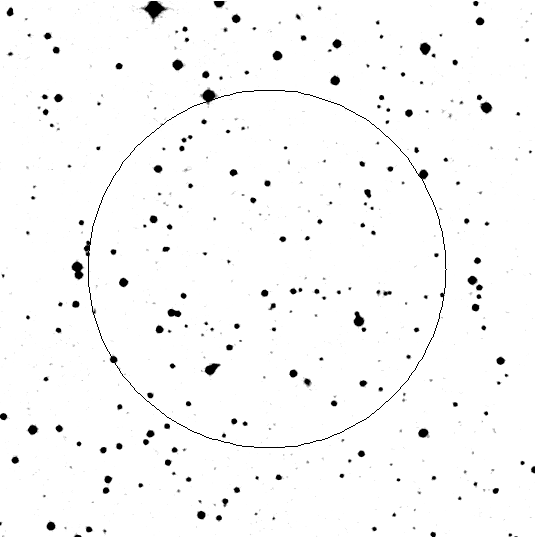
- GCN NOTICE
TITLE: GCN/INTEGRAL NOTICE
NOTICE_DATE: Thu 09 Jul 09 07:39:46 UT
NOTICE_TYPE: INTEGRAL SPI ACS Trigger
TRIGGER_NUM: 5897, Sub_Num: 0
GRB_INTEN: 9.18 [sigma]
GRB_TIME: 27512.50 SOD {07:38:32.50} UT
GRB_DATE: 15021 TJD; 190 DOY; 09/07/09
COMMENTS: INTEGRAL SPI_ACS GRB Trigger.
COMMENTS:
+ftp://isdcarc.unige.ch/arc/FTP/ibas/spiacs/2009-07/2009-07-09T07-38-32.4159-20471-00007-0.lc
- GCN NOTICE
TITLE: GCN/SWIFT NOTICE
NOTICE_DATE: Thu 09 Jul 09 07:42:15 UT
NOTICE_TYPE: Swift-BAT GRB Lightcurve
TRIGGER_NUM: 356890, Seg_Num: 0
GRB_RA: 289.933d {+19h 19m 44s} (J2000),
289.966d {+19h 19m 52s} (current),
289.759d {+19h 19m 02s} (1950)
GRB_DEC: +60.731d {+60d 43' 52"} (J2000),
+60.749d {+60d 44' 57"} (current),
+60.637d {+60d 38' 12"} (1950)
GRB_DATE: 15021 TJD; 190 DOY; 09/07/09
GRB_TIME: 27514.59 SOD {07:38:34.59} UT
TRIGGER_INDEX: 146
GRB_PHI: -93.21 [deg]
GRB_THETA: 19.11 [deg]
DELTA_TIME: 52.00 [sec]
TRIGGER_DUR: 1.024 [sec]
SOLN_STATUS: 0x3
RATE_SIGNIF: 43.54 [sigma]
IMAGE_SIGNIF: 17.31 [sigma]
LC_URL: sw00356890000msb.lc
SUN_POSTN: 108.68d {+07h 14m 44s} +22.33d {+22d 19' 35"}
SUN_DIST: 96.92 [deg] Sun_angle= 11.9 [hr] (West of Sun)
MOON_POSTN: 310.43d {+20h 41m 42s} -17.49d {-17d 29' 14"}
MOON_DIST: 79.95 [deg]
MOON_ILLUM: 97 [%]
GAL_COORDS: 91.82, 20.13 [deg] galactic lon,lat of the burst (or transient)
ECL_COORDS: 335.86, 79.48 [deg] ecliptic lon,lat of the burst (or transient)
COMMENTS: SWIFT-BAT GRB Lightcurve.
COMMENTS:
COMMENTS: The next comments were copied from the BAT_POS Notice:
COMMENTS: This is a rate trigger.
COMMENTS: A point_source was found.
COMMENTS: This does not match any source in the on-board catalog.
COMMENTS: This does not match any source in the ground catalog.
COMMENTS: This is a GRB.
COMMENTS: This trigger occurred at longitude,latitude = 244.76,-17.69 [deg].
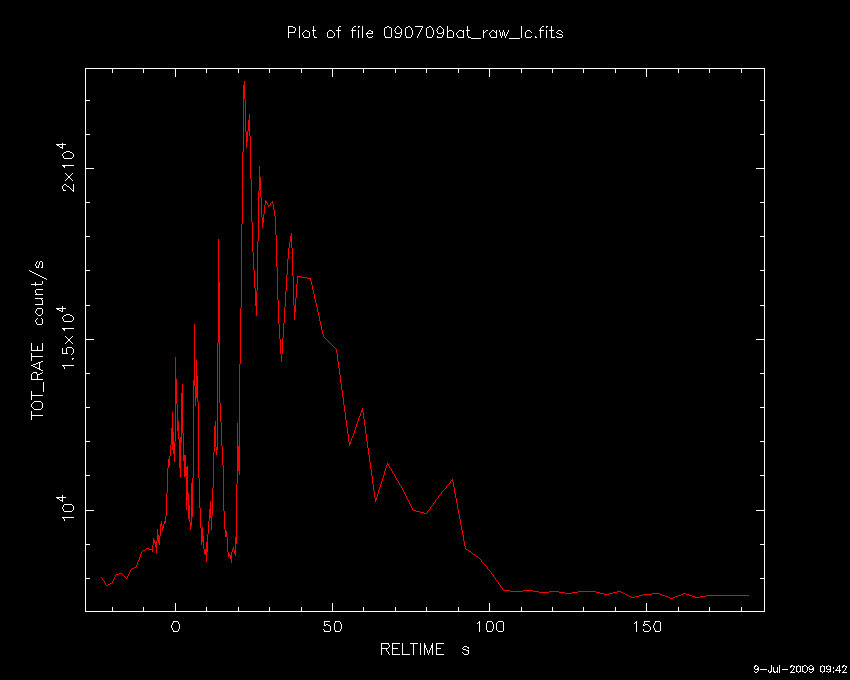
- GCN NOTICE
TITLE: GCN/SWIFT NOTICE
NOTICE_DATE: Thu 09 Jul 09 07:42:44 UT
NOTICE_TYPE: Swift-UVOT Source List
TRIGGER_NUM: 356890, Seg_Num: 0
POINT_RA: 289.918d {+19h 19m 40s} (J2000)
POINT_DEC: +60.713d {+60d 42' 47"} (J2000)
POINT_ROLL: 1.122d
IMG_START_DATE: 15021 TJD; 190 DOY; 09/07/09
IMG_START_TIME: 27591.46 SOD {07:39:51.46} UT, 76.9 [sec] since BAT Trigger Time
FILTER: 10, White
BKG_MEAN: 1.540
N_STARS: 121
X_OFFSET: 632 [pixels]
Y_OFFSET: 520 [pixels]
X_MAX: 1591 [pixels]
Y_MAX: 1479 [pixels]
DET_THRESH: 10
PHOTO_THRESH: 5
SL_URL: sw00356890000msufc0076.fits
SUN_POSTN: 108.68d {+07h 14m 44s} +22.33d {+22d 19' 35"}
SUN_DIST: 96.94 [deg] Sun_angle= 11.9 [hr] (West of Sun)
MOON_POSTN: 310.43d {+20h 41m 43s} -17.49d {-17d 29' 09"}
MOON_DIST: 79.94 [deg]
MOON_ILLUM: 97 [%]
GAL_COORDS: 91.80, 20.13 [deg] galactic lon,lat of the pointing direction
ECL_COORDS: 335.76, 79.47 [deg] ecliptic lon,lat of the pointing direction
COMMENTS: SWIFT-UVOT Source List.
- GCN NOTICE
TITLE: GCN/SWIFT NOTICE
NOTICE_DATE: Thu 09 Jul 09 07:43:23 UT
NOTICE_TYPE: Swift-UVOT Processed Source List
TRIGGER_NUM: 356890, Seg_Num: 0
POINT_RA: 289.918d {+19h 19m 40s} (J2000)
POINT_DEC: +60.713d {+60d 42' 47"} (J2000)
POINT_ROLL: 1.122d
IMG_START_DATE: 15021 TJD; 190 DOY; 09/07/09
IMG_START_TIME: 27591.46 SOD {07:39:51.46} UT, 76.9 [sec] since BAT Trigger Time
FILTER: 10, White
BKG_MEAN: 1.540
N_STARS: 121
X_OFFSET: 632 [pixels]
Y_OFFSET: 520 [pixels]
X_MAX: 1591 [pixels]
Y_MAX: 1479 [pixels]
DET_THRESH: 10
PHOTO_THRESH: 5
SL_URL: sw00356890000msufc0076.fits
SUN_POSTN: 108.69d {+07h 14m 44s} +22.33d {+22d 19' 35"}
SUN_DIST: 96.94 [deg] Sun_angle= 11.9 [hr] (West of Sun)
MOON_POSTN: 310.44d {+20h 41m 44s} -17.48d {-17d 29' 02"}
MOON_DIST: 79.94 [deg]
MOON_ILLUM: 97 [%]
GAL_COORDS: 91.80, 20.13 [deg] galactic lon,lat of the pointing direction
ECL_COORDS: 335.76, 79.47 [deg] ecliptic lon,lat of the pointing direction
COMMENTS: SWIFT-UVOT Processed Source List.
COMMENTS: All 4 attachments are included.
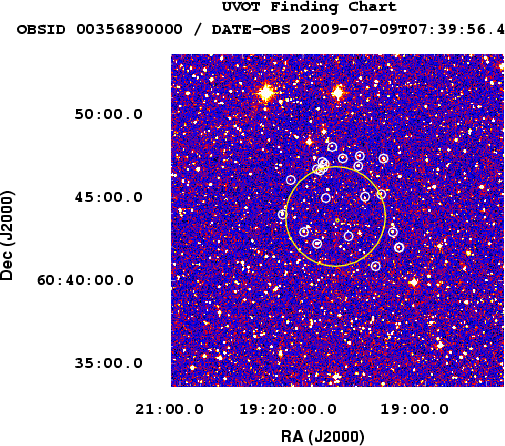
- GCN NOTICE
TITLE: GCN/SWIFT NOTICE
NOTICE_DATE: Thu 09 Jul 09 07:50:17 UT
NOTICE_TYPE: Swift-UVOT Image
TRIGGER_NUM: 356890, Seg_Num: 0
POINT_RA: 289.920d {+19h 19m 41s} (J2000)
POINT_DEC: +60.710d {+60d 42' 35"} (J2000)
ROLL: 1.125d
IMG_START_DATE: 15021 TJD; 190 DOY; 09/07/09
IMG_START_TIME: 27804.41 SOD {07:43:24.41} UT, 289.8 [sec] since BAT Trigger Time
FILTER: 7, U
EXPOSURE_ID: 268818209
X_OFFSET: 919 [pixels]
Y_OFFSET: 843 [pixels]
WIDTH: 160 [pixels]
HEIGHT: 160 [pixels]
X_GRB_POS: 1079
Y_GRB_POS: 1003
BINNING_INDEX: 1
IM_URL: sw00356890000msuni0294.fits
SUN_POSTN: 108.69d {+07h 14m 46s} +22.33d {+22d 19' 32"}
SUN_DIST: 96.94 [deg] Sun_angle= 11.9 [hr] (West of Sun)
MOON_POSTN: 310.49d {+20h 41m 58s} -17.46d {-17d 27' 51"}
MOON_DIST: 79.92 [deg]
MOON_ILLUM: 97 [%]
GAL_COORDS: 91.79, 20.13 [deg] galactic lon,lat of the pointing direction
ECL_COORDS: 335.75, 79.47 [deg] ecliptic lon,lat of the pointing direction
COMMENTS: SWIFT-UVOT Image.
COMMENTS: The GRB Position came from the XRT Position Command.
COMMENTS: The image has 2x2 binning (compression).
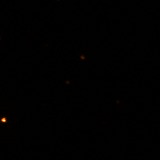
- GCN NOTICE
TITLE: GCN/SWIFT NOTICE
NOTICE_DATE: Thu 09 Jul 09 07:49:10 UT
NOTICE_TYPE: Swift-UVOT Source List
TRIGGER_NUM: 356890, Seg_Num: 0
POINT_RA: 289.920d {+19h 19m 41s} (J2000)
POINT_DEC: +60.710d {+60d 42' 35"} (J2000)
POINT_ROLL: 1.125d
IMG_START_DATE: 15021 TJD; 190 DOY; 09/07/09
IMG_START_TIME: 27804.41 SOD {07:43:24.41} UT, 289.8 [sec] since BAT Trigger Time
FILTER: 7, U
BKG_MEAN: 0.327
N_STARS: 60
X_OFFSET: 599 [pixels]
Y_OFFSET: 523 [pixels]
X_MAX: 1558 [pixels]
Y_MAX: 1482 [pixels]
DET_THRESH: 6
PHOTO_THRESH: 2
SL_URL: sw00356890000msufc0289.fits
SUN_POSTN: 108.69d {+07h 14m 45s} +22.33d {+22d 19' 33"}
SUN_DIST: 96.94 [deg] Sun_angle= 11.9 [hr] (West of Sun)
MOON_POSTN: 310.48d {+20h 41m 56s} -17.47d {-17d 28' 03"}
MOON_DIST: 79.92 [deg]
MOON_ILLUM: 97 [%]
GAL_COORDS: 91.79, 20.13 [deg] galactic lon,lat of the pointing direction
ECL_COORDS: 335.75, 79.47 [deg] ecliptic lon,lat of the pointing direction
COMMENTS: SWIFT-UVOT Source List.
- GCN NOTICE
TITLE: GCN/SWIFT NOTICE
NOTICE_DATE: Thu 09 Jul 09 07:42:44 UT
NOTICE_TYPE: Swift-UVOT Source List
TRIGGER_NUM: 356890, Seg_Num: 0
POINT_RA: 289.918d {+19h 19m 40s} (J2000)
POINT_DEC: +60.713d {+60d 42' 47"} (J2000)
POINT_ROLL: 1.122d
IMG_START_DATE: 15021 TJD; 190 DOY; 09/07/09
IMG_START_TIME: 27591.46 SOD {07:39:51.46} UT, 76.9 [sec] since BAT Trigger Time
FILTER: 10, White
BKG_MEAN: 1.540
N_STARS: 121
X_OFFSET: 632 [pixels]
Y_OFFSET: 520 [pixels]
X_MAX: 1591 [pixels]
Y_MAX: 1479 [pixels]
DET_THRESH: 10
PHOTO_THRESH: 5
SL_URL: sw00356890000msufc0076.fits
SUN_POSTN: 108.68d {+07h 14m 44s} +22.33d {+22d 19' 35"}
SUN_DIST: 96.94 [deg] Sun_angle= 11.9 [hr] (West of Sun)
MOON_POSTN: 310.43d {+20h 41m 43s} -17.49d {-17d 29' 09"}
MOON_DIST: 79.94 [deg]
MOON_ILLUM: 97 [%]
GAL_COORDS: 91.80, 20.13 [deg] galactic lon,lat of the pointing direction
ECL_COORDS: 335.76, 79.47 [deg] ecliptic lon,lat of the pointing direction
COMMENTS: SWIFT-UVOT Source List.
- GCN NOTICE
TITLE: GCN/SWIFT NOTICE
NOTICE_DATE: Thu 09 Jul 09 07:44:31 UT
NOTICE_TYPE: Swift-UVOT Processed Image
TRIGGER_NUM: 356890, Seg_Num: 0
POINT_RA: 289.918d {+19h 19m 40s} (J2000)
POINT_DEC: +60.713d {+60d 42' 47"} (J2000)
ROLL: 1.122d
IMG_START_DATE: 15021 TJD; 190 DOY; 09/07/09
IMG_START_TIME: 27591.46 SOD {07:39:51.46} UT, 76.9 [sec] since BAT Trigger Time
FILTER: 10, White
EXPOSURE_ID: 268817996
X_OFFSET: 919 [pixels]
Y_OFFSET: 843 [pixels]
WIDTH: 160 [pixels]
HEIGHT: 160 [pixels]
X_GRB_POS: 1079
Y_GRB_POS: 1003
BINNING_INDEX: 1
IM_URL: sw00356890000msuni0081.fits
SUN_POSTN: 108.69d {+07h 14m 45s} +22.33d {+22d 19' 34"}
SUN_DIST: 96.94 [deg] Sun_angle= 11.9 [hr] (West of Sun)
MOON_POSTN: 310.44d {+20h 41m 47s} -17.48d {-17d 28' 50"}
MOON_DIST: 79.93 [deg]
MOON_ILLUM: 97 [%]
GAL_COORDS: 91.80, 20.13 [deg] galactic lon,lat of the pointing direction
ECL_COORDS: 335.76, 79.47 [deg] ecliptic lon,lat of the pointing direction
COMMENTS: SWIFT-UVOT Processed Image.
COMMENTS: The GRB Position came from the XRT Position Command.
COMMENTS: The image has 2x2 binning (compression).
COMMENTS: All 4 attachments are included.
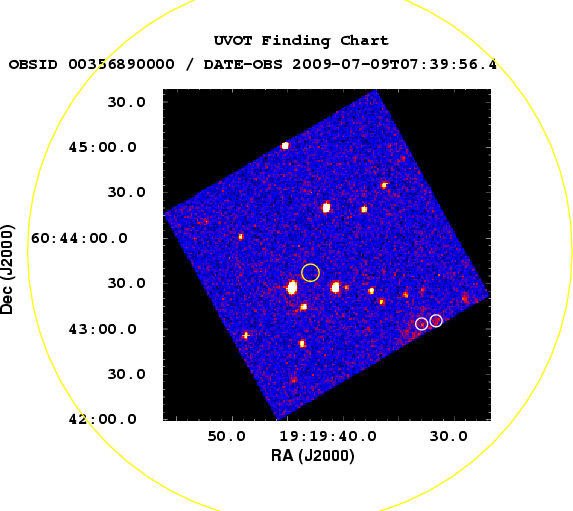
- GCN NOTICE
TITLE: GCN/SWIFT NOTICE
NOTICE_DATE: Thu 09 Jul 09 07:50:35 UT
NOTICE_TYPE: Swift-UVOT Processed Image
TRIGGER_NUM: 356890, Seg_Num: 0
POINT_RA: 289.920d {+19h 19m 41s} (J2000)
POINT_DEC: +60.710d {+60d 42' 35"} (J2000)
ROLL: 1.125d
IMG_START_DATE: 15021 TJD; 190 DOY; 09/07/09
IMG_START_TIME: 27804.41 SOD {07:43:24.41} UT, 289.8 [sec] since BAT Trigger Time
FILTER: 7, U
EXPOSURE_ID: 268818209
X_OFFSET: 919 [pixels]
Y_OFFSET: 843 [pixels]
WIDTH: 160 [pixels]
HEIGHT: 160 [pixels]
X_GRB_POS: 1079
Y_GRB_POS: 1003
BINNING_INDEX: 1
IM_URL: sw00356890000msuni0294.fits
SUN_POSTN: 108.69d {+07h 14m 46s} +22.33d {+22d 19' 32"}
SUN_DIST: 96.94 [deg] Sun_angle= 11.9 [hr] (West of Sun)
MOON_POSTN: 310.49d {+20h 41m 58s} -17.46d {-17d 27' 48"}
MOON_DIST: 79.92 [deg]
MOON_ILLUM: 97 [%]
GAL_COORDS: 91.79, 20.13 [deg] galactic lon,lat of the pointing direction
ECL_COORDS: 335.75, 79.47 [deg] ecliptic lon,lat of the pointing direction
COMMENTS: SWIFT-UVOT Processed Image.
COMMENTS: The GRB Position came from the XRT Position Command.
COMMENTS: The image has 2x2 binning (compression).
COMMENTS: All 4 attachments are included.
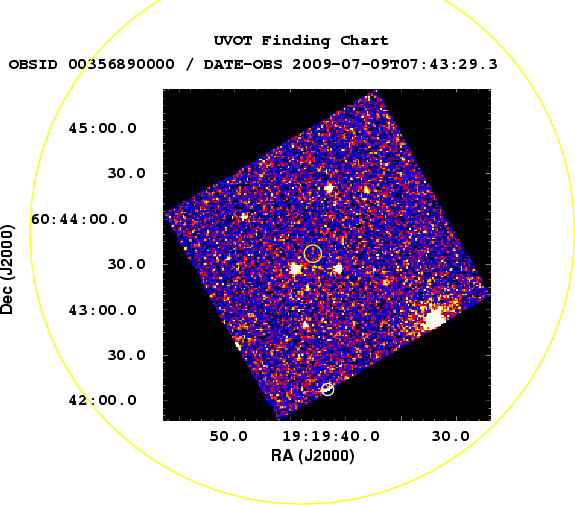
- GCN NOTICE
TITLE: GCN/SWIFT NOTICE
NOTICE_DATE: Thu 09 Jul 09 07:49:10 UT
NOTICE_TYPE: Swift-UVOT Source List
TRIGGER_NUM: 356890, Seg_Num: 0
POINT_RA: 289.920d {+19h 19m 41s} (J2000)
POINT_DEC: +60.710d {+60d 42' 35"} (J2000)
POINT_ROLL: 1.125d
IMG_START_DATE: 15021 TJD; 190 DOY; 09/07/09
IMG_START_TIME: 27804.41 SOD {07:43:24.41} UT, 289.8 [sec] since BAT Trigger Time
FILTER: 7, U
BKG_MEAN: 0.327
N_STARS: 60
X_OFFSET: 599 [pixels]
Y_OFFSET: 523 [pixels]
X_MAX: 1558 [pixels]
Y_MAX: 1482 [pixels]
DET_THRESH: 6
PHOTO_THRESH: 2
SL_URL: sw00356890000msufc0289.fits
SUN_POSTN: 108.69d {+07h 14m 45s} +22.33d {+22d 19' 33"}
SUN_DIST: 96.94 [deg] Sun_angle= 11.9 [hr] (West of Sun)
MOON_POSTN: 310.48d {+20h 41m 56s} -17.47d {-17d 28' 03"}
MOON_DIST: 79.92 [deg]
MOON_ILLUM: 97 [%]
GAL_COORDS: 91.79, 20.13 [deg] galactic lon,lat of the pointing direction
ECL_COORDS: 335.75, 79.47 [deg] ecliptic lon,lat of the pointing direction
COMMENTS: SWIFT-UVOT Source List.
- GCN NOTICE
TITLE: GCN/SWIFT NOTICE
NOTICE_DATE: Thu 09 Jul 09 07:44:04 UT
NOTICE_TYPE: Swift-UVOT Image
TRIGGER_NUM: 356890, Seg_Num: 0
POINT_RA: 289.918d {+19h 19m 40s} (J2000)
POINT_DEC: +60.713d {+60d 42' 47"} (J2000)
ROLL: 1.122d
IMG_START_DATE: 15021 TJD; 190 DOY; 09/07/09
IMG_START_TIME: 27591.46 SOD {07:39:51.46} UT, 76.9 [sec] since BAT Trigger Time
FILTER: 10, White
EXPOSURE_ID: 268817996
X_OFFSET: 919 [pixels]
Y_OFFSET: 843 [pixels]
WIDTH: 160 [pixels]
HEIGHT: 160 [pixels]
X_GRB_POS: 1079
Y_GRB_POS: 1003
BINNING_INDEX: 1
IM_URL: sw00356890000msuni0081.fits
SUN_POSTN: 108.69d {+07h 14m 45s} +22.33d {+22d 19' 34"}
SUN_DIST: 96.94 [deg] Sun_angle= 11.9 [hr] (West of Sun)
MOON_POSTN: 310.44d {+20h 41m 46s} -17.48d {-17d 28' 55"}
MOON_DIST: 79.93 [deg]
MOON_ILLUM: 97 [%]
GAL_COORDS: 91.80, 20.13 [deg] galactic lon,lat of the pointing direction
ECL_COORDS: 335.76, 79.47 [deg] ecliptic lon,lat of the pointing direction
COMMENTS: SWIFT-UVOT Image.
COMMENTS: The GRB Position came from the XRT Position Command.
COMMENTS: The image has 2x2 binning (compression).
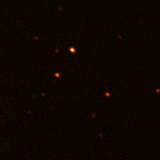
- GCN NOTICE
TITLE: GCN/SWIFT NOTICE
NOTICE_DATE: Thu 09 Jul 09 07:49:39 UT
NOTICE_TYPE: Swift-UVOT Processed Source List
TRIGGER_NUM: 356890, Seg_Num: 0
POINT_RA: 289.920d {+19h 19m 41s} (J2000)
POINT_DEC: +60.710d {+60d 42' 35"} (J2000)
POINT_ROLL: 1.125d
IMG_START_DATE: 15021 TJD; 190 DOY; 09/07/09
IMG_START_TIME: 27804.41 SOD {07:43:24.41} UT, 289.8 [sec] since BAT Trigger Time
FILTER: 7, U
BKG_MEAN: 0.327
N_STARS: 60
X_OFFSET: 599 [pixels]
Y_OFFSET: 523 [pixels]
X_MAX: 1558 [pixels]
Y_MAX: 1482 [pixels]
DET_THRESH: 6
PHOTO_THRESH: 2
SL_URL: sw00356890000msufc0289.fits
SUN_POSTN: 108.69d {+07h 14m 45s} +22.33d {+22d 19' 33"}
SUN_DIST: 96.94 [deg] Sun_angle= 11.9 [hr] (West of Sun)
MOON_POSTN: 310.49d {+20h 41m 57s} -17.47d {-17d 27' 58"}
MOON_DIST: 79.92 [deg]
MOON_ILLUM: 97 [%]
GAL_COORDS: 91.79, 20.13 [deg] galactic lon,lat of the pointing direction
ECL_COORDS: 335.75, 79.47 [deg] ecliptic lon,lat of the pointing direction
COMMENTS: SWIFT-UVOT Processed Source List.
COMMENTS: All 4 attachments are included.
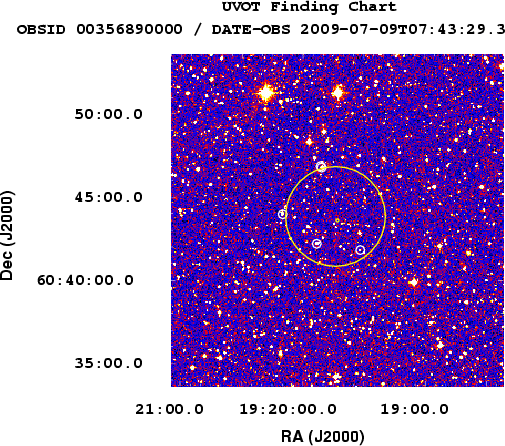
- GCN NOTICE
TITLE: GCN/SWIFT NOTICE
NOTICE_DATE: Thu 09 Jul 09 08:04:10 UT
NOTICE_TYPE: Swift-XRT Position
TRIGGER_NUM: 356890, Seg_Num: 0
GRB_RA: 289.9291d {+19h 19m 42.98s} (J2000),
289.9622d {+19h 19m 50.91s} (current),
289.7549d {+19h 19m 01.16s} (1950)
GRB_DEC: +60.7271d {+60d 43' 37.5"} (J2000),
+60.7452d {+60d 44' 42.6"} (current),
+60.6326d {+60d 37' 57.3"} (1950)
GRB_ERROR: 4.0 [arcsec radius, statistical plus systematic, 90% containment]
GRB_INTEN: 1.00e-10 [erg/cm2/sec]
GRB_SIGNIF: 10.00 [sigma]
IMG_START_DATE: 15021 TJD; 190 DOY; 09/07/09
IMG_START_TIME: 27582.40 SOD {07:39:42.40} UT, 67.8 [sec] since BAT Trigger Time
TAM[0-3]: 327.61 237.19 261.35 242.66
AMPLIFIER: 2
WAVEFORM: 134
SUN_POSTN: 108.70d {+07h 14m 48s} +22.32d {+22d 19' 28"}
SUN_DIST: 96.92 [deg] Sun_angle= 11.9 [hr] (West of Sun)
MOON_POSTN: 310.60d {+20h 42m 25s} -17.42d {-17d 25' 29"}
MOON_DIST: 79.92 [deg]
MOON_ILLUM: 97 [%]
GAL_COORDS: 91.81, 20.13 [deg] galactic lon,lat of the burst
ECL_COORDS: 335.84, 79.47 [deg] ecliptic lon,lat of the burst
COMMENTS: SWIFT-XRT Coordinates.
COMMENTS: This Notice was ground-generated -- not flight-generated.
COMMENTS: TAM values are not valid.
COMMENTS: This position was manually determined
- GCN Circular #9625
D. C. Morris (PSU), A. P. Beardmore (U Leicester),
P. A. Evans (U Leicester), H. A. Krimm (CRESST/GSFC/USRA),
V. Mangano (INAF-IASFPA), J. Mao (INAF-OAB),
C. B. Markwardt (CRESST/GSFC/UMD), K. L. Page (U Leicester),
D. M. Palmer (LANL), A. Rowlinson (U Leicester), M. H. Siegel (PSU),
M. A. Stark (PSU), G. Tagliaferri (INAF-OAB),
T. N. Ukwatta (GSFC/GWU) and H. Ziaeepour (UCL-MSSL) report on behalf
of the Swift Team:
At 07:38:34 UT, the Swift Burst Alert Telescope (BAT) triggered and
located GRB 090709 (trigger=356890). Swift slewed immediately to the burst.
The BAT on-board calculated location is
RA, Dec 289.933, +60.731 which is
RA(J2000) = 19h 19m 44s
Dec(J2000) = +60d 43' 52"
with an uncertainty of 3 arcmin (radius, 90% containment, including
systematic uncertainty). The BAT light curve showed about four major
peaks starting at T-20 and continuing to T+100 seconds. The peak
count rate was ~15000 counts/sec (15-350 keV), at ~25 sec after the trigger.
The XRT began observing the field at 07:39:42 UT, 67.8 seconds after the BAT
trigger. In the 2.5-s image-mode data we find a fading, uncatalogued X-ray
source with a position: RA, Dec 289.9291, +60.7271 which is equivalent to:
RA(J2000) = 19h 19m 42.99s
Dec(J2000) = +60d 43' 37.5"
with an uncertainty of 4 arcseconds (radius, 90% containment). This
location is 16 arcseconds from the BAT onboard position, within the BAT
error circle.
UVOT took a finding chart exposure of 150 seconds with the White filter
starting 76 seconds after the BAT trigger. No credible afterglow candidate has
been found in the initial data products. The overlap of the sub-image and the
XRT error circle is 100%. The overlap of the 8'x8' region for the list of
sources generated on-board and the XRT error circle is 100%. No correction
has been made for the expected extinction corresponding to E(B-V) of 0.09.
Burst Advocate for this burst is D. C. Morris (morris AT astro.psu.edu).
Please contact the BA by email if you require additional information
regarding Swift followup of this burst. In extremely urgent cases, after
trying the Burst Advocate, you can contact the Swift PI by phone (see
Swift TOO web site for information: http://www.swift.psu.edu/too.html.)
- GCN Circular #9626
S. B. Pandey (U Mich), W. Rujopakarn (Steward), H. Flewelling (IfA/
Hawaii), F. Yuan (U Mich), B. E. Schaefer (Louisiana State), report on
behalf of the ROTSE collaboration:
ROTSE-IIIb, located at McDonald Observatory, Texas, responded to GRB
090709 (Swift trigger 356890; Morris D. C., GCN 9625), producing
images beginning 5.6 s after the GCN notice time. An automated
response took the first image at 07:39:00.6 UT, 26.0 s after the
burst, and during the gamma-ray emission, under good conditions. We
took 10 5-sec and 50 20-sec exposures. These unfiltered images are
calibrated relative to USNO A2.0 (R). Imaging is on going.
Comparison to the DSS (second epoch) reveals no new sources within the
3-sigma Swift/BAT error circle or the XRT error circle, for both
single images and coadding into sets of 10. Individual images have
limiting magnitudes ranging from 16.4-17.2; we set the following
specific limits.
start UT end UT t_exp(s) mlim t_start-tGRB(s) Coadd?
--------------------------------------------------------------------
07:39:00.6 07:39:05.6 5 16.5 26.0 N
07:39:00.6 07:40:07.7 67 17.8 26.0 Y
07:40:20.2 07:45:02.4 282 18.2 105.6 Y
- GCN Circular #9628
A. N. Morgan, C. R. Klein, D. A. Perley, J. S. Bloom, (UC Berkeley), report:
We observed the field of GRB 090709 (Morris et al., GCN 9625) with the
1.3m PAIRITEL located at Mt. Hopkins, Arizona. Observations began at
2009-07-09 07:40:22 UT, ~108 seconds after the Swift trigger. In
preliminary mosaics (effective exposure time of ~374 seconds) taken
simultaneously in the J, H, and Ks filters, we detect no source at the
XRT position.
The preliminary photometry yields:
post_burst
t_mid(s) exp(s) filt U. Limit (3 sig)
438 374 J > 17.7
438 374 H > 16.9
438 374 Ks > 15.3
All magnitudes given in the Vega system, calibrated to 2MASS. No
correction for Galactic extinction has been made to the above reported
values. Observations are ongoing.
- GCN Circular #9630
GRB 090709: Faulkes Telescope North Upper Limits
Z. Cano (Liverpool JMU), A. Melandri, C. Guidorzi (U. Ferrara), D. Bersier,
I.A. Steele, R.J. Smith, C. Mundell (Liverpool JMU)
report, on behalf of a large collaboration:
Following Swift detection of burst (Morris et al. GCN Circ. 9625), Faulkes
Telescope North (Hawaii) reacted robotically and began observing the field
of GRB 090709 in BVRi bands starting at 07:41:27 UT.
We detect no new source within the XRT error circle:
t_exp t-T0(mid exposure) mag
30s 207 s R2 > 19.3
180s 457 s I > 18.3
The upper limits are determined against stars in the USNO B1 catalog.
- GCN Circular #9632
Kazuhisa Mitsuda on behalf of the Suzaku GRB-ToO team:
We will carry out a Suzaku-ToO observation of GRB 090709
(Morris et al., GCN 9625) at location (RA=289.9291, DEC=+60.7271,
J2000) with the narrow field instruments (the XIS and HXD).
It will start 13:00 UT on July 9, 2009, and
will continue until 21:32 UT on July 10, 2009.
- GCN Circular #9634
K. Aoki, M. Ishii (Subaru Telescope), M. Kuzuhara (Univ. of Tokyo),
Y. Takahashi (Univ. of Advanced Study) and N. Kawai (Tokyo Tech)
report on behalf of the Subaru GRB team:
We observed the field of GRB 090709A (Morris et al. GCN 9625)
with MOIRCS on Subaru Telescope in J and K bands under a
cirrus condition, starting at ~9:30 UT on July 9, approximately
2 hours after the burst.
We detected following two objects near the XRT error circle.
Their preliminary magnitudes based on a nearby 2MASS star are following.
object A: J(Vega)=19.0, K(Vega)=18.2
object B: J undetected, K(Vega)=18.6
We placed the K band finding chart at
http://www.hp.phys.titech.ac.jp/nkawai/grb/090709/GRB090709.jpg
We further performed spectroscopy for them with the following results:
Object A: zJH spectroscopy, a flat spectrum with no break detected.
Object B: HK and zJH spectroscopy, a continuum detected in K-band,
no continuum detected in J band,
possibly no continuum in H-band but with high background.
Lack of H band continuum could suggest that the object B is at high
redshift (z~10), though its poor SNR does not allow us to confirm it.
Fading is not confirmed for either of them.
Further NIR/optical observations are strongly encouraged.
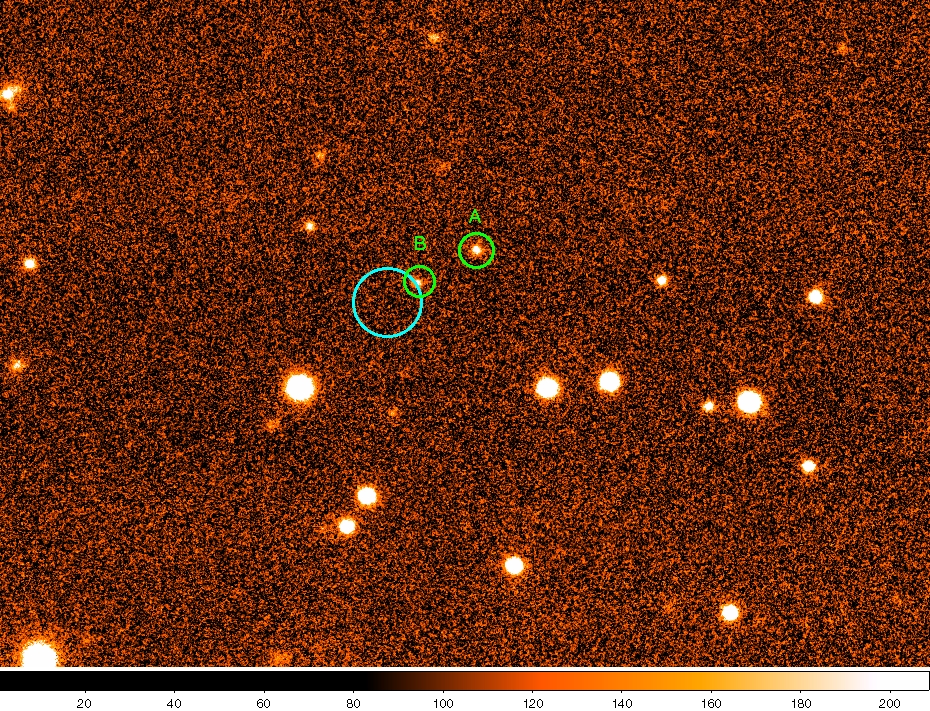
- GCN Circular #9635
A. N. Morgan, J. S. Bloom, C. R. Klein (UC Berkeley), report:
Using a re-reduction of the early PAIRITEL data for GRB 090709A
(Morgan et al. GCN 9628) we report a probable detection of a red
source in the H and Ks bands within the XRT circle (Morris et al. GCN
9625). The source is located at the following J2000 position (3.15
arcsec away from the center of the current XRT position):
RA = 19:19:42.64
Dec = +60:43:39.3
The uncertainty in this position relative to the ICRS is 0.4" in each direction.
The preliminary photometry yields:
post_burst
t_mid(s) exp(s) filt mag
438 374 J > 17.7 (3 sig)
438 374 H 16.7 +/- 0.2
438 374 Ks 15.3 +/- 0.2
Deeper mosaics obtained later in the night do not contain this source,
indicating that it has faded. We thus conclude that this is the
afterglow of GRB 090709A. Note that this is the same source 'B' as
that was just reported in Aoki et al. (GCN 9634). Our detection in
the H band places a less stringent redshift limit on the afterglow
(although this limit is still high; z > 8.5), if indeed our
non-detection in J is due to a Lyman break and not extinction. We
also note that source 'A' of GCN 9634, which is of comparable
brightness to 'B' 2 hours after the burst, is not detected in our
shallower image, confirming our conclusion that source 'B' has faded
and is the afterglow.
All magnitudes given in the Vega system, calibrated to 2MASS. No
correction for Galactic extinction has been made to the above reported
values.
- GCN Circular #9636
J.P. Osborne, A.P. Beardmore, P.A. Evans and M.R. Goad (U. Leicester)
report on behalf of the Swift-XRT team.
Using 2188 s of XRT Photon Counting mode data and 6 UVOT
images for GRB 090709A, we find an astrometrically corrected X-ray
position (using the XRT-UVOT alignment and matching UVOT field sources
to the USNO-B1 catalogue): RA, Dec = 289.92664, +60.72764 which is equivalent
to:
RA (J2000): 19h 19m 42.39s
Dec (J2000): +60d 43' 39.5"
with an uncertainty of 1.5 arcsec (radius, 90% confidence).
This position may be improved as more data are received. The latest
position can be viewed at http://www.swift.ac.uk/xrt_positions. Position
enhancement is described by Goad et al. (2007, A&A, 476, 1401) and Evans
et al. (2009, arXiv:0812.3662).
This circular was automatically generated, and is an official product of the
Swift-XRT team.
- GCN Circular #9637
K.Kono, E.Sonoda, N.Ohmori, H.hayasi,
A.Daikyuji, Y.Nisioka, K.Noda, M.Yamauchi
(University of Miyazaki)
We have observed the field covering the error circle of
GRB090709A (Swift trigger 356890, GCN 9625, D.C.Morriset al.)
with the unfiltered CCD camera on the 30-cm telescope
at University of Miyazaki.
The observation was started 11:42:32 UT (4.1 hr after the Swift trigger),
under cloudy condition.
First analyzable image was obtained at 16:18:26 UT (8.8 hr after the
Swift trigger).
We have compared our data of 30 sec exposures
with the USNO-A2.0 catalog,
There is no new source at the reported position.
(GCN 9634, K.Aoki et al. GCN 9636, J.P.Osborne et al.)
the upper limits are as follows:
--------------------------------------------------------------
Start(UT) End(UT) Num. of frames Limit (mag.)
--------------------------------------------------------------
16:18:26 16:18:56 1 13.6
16:18:26 18:39:38 38 16.4
---------------------------------------------------------------
- GCN Circular #9638
GRB 090709A: Wyoming Infrared Observatory NIR upper limits
Jay Norris (U. Denver),
Jerry Bonnell (CRESST/UMCP/GSFC),
Tzitlaly Barajas (Los Angeles City College),
Amanda McAuley (Cal State U. Los Angeles)
report on behalf of the Goddard/Univ. Wyoming NIR camera collaboration.
We observed the Swift XRT position reported by Morris et al. (GCN
Circ. 9625) for GRB 090709A with the 2.3-meter WIRO telescope and
the Goddard IR camera starting 52 minutes after the Swift trigger.
Using stacked J- and K- band exposures begining at 08:30 UT, we
derive the following 2 sigma upper limits for the afterglow source
reported by Morgan et al. (GCN Circ. 9635) from PAIRITEL observations.
Tmid (UT) Mag
09:30 J-band > 21.5
09:55 K-band > 18.5
The source is designated source B in the Subaru K-band finder chart
from Aoki et al. (GCN Circ. 9634).
Our K-band observations were compromised by cirrus. Our upper limits
are derived based on a comparison with two field stars with J-band
magnitudes 14.5 and 15.7 in the 2MASS catalog.
Further analysis of J- and K-band images is ongoing.
- GCN Circular #9639
Nat Butler (UC Berkeley) Reports:
We reduce the Swift XRT and BAT data using our automated pipeline (see,
http://astro.berkeley.edu/~nat/swift for more details of the fits and
summary plots for this and other Swift GRBs).
The intermediate time PC mode XRT data (t=4-10 ksec post trigger) are
well-fit (chi^2/nu=80.48/59) by an absorbed powerlaw with photon index
Gamma=1.9+/-0.1 and column density 1.7+/-0.5 x 10^21 cm^-2 in excess of
the anticipated Galactic contribution (6.6 x 10^20 cm^-2) at the 6.7-sigma
level. This detection of an excess column is suggestive of a low to
moderate redshift (i.e., z<~2) for the GRB (e.g,. Grupe et al. 2007, ApJ,
133, 2216).
The time-integrated BAT spectrum is well-modeled by a powerlaw times
exponential function (chi^2/nu=29.67/55). We derive Epeak,obs = 200
(176,298) keV and a rest-frame isotropic equivalent energy release Eiso ~
1.4 x 10^53 erg (z=1). If the GRB were at very high z~8, Eiso ~ 4.5 x
10^54 erg, comparable to the intrinsically brightest few GRBs ever detected,
further suggestive of a low to moderate redshift for this event.
- GCN Circular #9640
T. Sakamoto (GSFC/UMBC), S. D. Barthelmy (GSFC), W. H. Baumgartner (GSFC/UMBC),
J. R. Cummings (GSFC/UMBC), E. E. Fenimore (LANL), N. Gehrels (GSFC),
H. A. Krimm (GSFC/USRA), C. B. Markwardt (GSFC/UMD), D. C. Morris (PSU),
D. M. Palmer (LANL), G. Sato (ISAS), M. Stamatikos (GSFC/ORAU),
J. Tueller (GSFC), T. N. Ukwatta (GWU)
(i.e. the Swift-BAT team):
Using the data set from T-239 to T+505 sec from recent telemetry downlinks,
we report further analysis of BAT GRB 090709A (trigger #356890)
(Morris, et al., GCN Circ. 9625). The BAT ground-calculated position is
RA, Dec = 289.944, 60.728 deg, which is
RA(J2000) = 19h 19m 46.7s
Dec(J2000) = +60d 43' 40.8"
with an uncertainty of 1.0 arcmin, (radius, sys+stat, 90% containment).
The partial coding was 75%.
The mask-weighted light curve shows a complex structure. It starts
at ~T-80 sec, peaks at T-70 sec, and returns to almost background
at ~T-20 sec. Then a series of overlapping peaks starts with the
brightest centered at ~T+22 sec. Then begins an exponential decay
with a series of decreases eventually returning to background level
at ~T+270 sec. There two more peaks at ~T+330 and ~T+400 sec. A third peak
is chopped off while still rising when the source went out of the BAT FOV
at ~T+490 sec due to the spacecraft slewing because of an observing constraint.
T90 (15-350 keV) is 89 +- 3 sec (estimated error including systematics).
The time-averaged spectrum from T-66.7 to T+101.5 sec is well fit by
simple power law. The power law index of the time-averaged spectrum is
1.22 +- 0.03. The fluence in the 15-150 keV band is 2.57 +- 0.03 x 10^-5 erg/cm2.
The 1-sec peak photon flux measured from T+21.80 sec in the 15-150 keV band
is 7.8 +- 0.3 ph/cm2/sec. All the quoted errors are at the 90% confidence
level.
The results of the batgrbproduct analysis are available at
http://gcn.gsfc.nasa.gov/notices_s/356890/BA/
- GCN Circular #9642
A. Rowlinson (U Leicester) and D. C. Morris (PSU) report on behalf of
the Swift-XRT team:
We have analysed 9.4 ks of XRT data for GRB 090709A (Morris et al. GCN
Circ. 9625), from 74 s to 27.3 ks after the BAT trigger. The data
comprise 445 s in Windowed Timing (WT) mode with the remainder in Photon
Counting (PC) mode. The enhanced XRT position for this burst was given
by Osborne et al. (GCN. Circ 9636).
The light curve can be modelled with a broken power-law decay. The
initial decay index is alpha=3D0.77(+/-0.1), at T+7918 s the light curve
breaks to a decay with alpha=3D1.51(+/-0.06).
A spectrum formed from the WT mode data can be fitted with an absorbed
power-law with a photon spectral index of 1.78 (+/-0.04). The
best-fitting absorption column is 2.14 (+0.13, -0.12) x 10^21 cm^-2, in
excess of the Galactic value of 6.6 x 10^20 cm^-2 (Kalberla et al.
2005). The PC mode spectrum has a photon index of 2.05 (+/-0.08) and a
best-fitting absorption column of 2.68 (+0.26, -0.25) x 10^21 cm^-2. The
counts to observed (unabsorbed) 0.3-10 keV flux conversion factor
deduced from this spectrum is 4.2 x 10^-11 (6.7 x 10^-11) erg cm^-2
count^-1.
If the light curve continues to decay with a power-law decay index of
1.51, the count rate at T+24 hours will be 0.043 count s^-1,
corresponding to an observed (unabsorbed) 0.3-10 keV flux of=C2=A0 1.8 x
10^-12 (2.9 x 10^-12) erg cm^-2 s^-1.
The results of the XRT-team automatic analysis are available at
http://www.swift.ac.uk/xrt_products/00356890.
This circular is an official product of the Swift-XRT team.
- GCN Circular #9643
J. Wren, W.T. Vestrand, P.R. Wozniak, H. Davis, B. Norman
of Los Alamos National Laboratory report:
The RAPTOR telescope system responded to Swift trigger
356890 (Morris et al., GCN 9625) under good observing conditions.
Our narrow-field instruments began observing the location at
07:39:03.4 UTC, 28.8 s after the Swift trigger (7.1 s after
receipt of GCN message). We obtained simultaneous observations
during the gamma-ray emitting interval in Cousins V, R, and I
bands as well as unfiltered data. We do not detect the counterpart
observed by the Subaru Telescope (Aoki et al., GCN 9634) and
PARITEL (Morgan et al., GCN 9635). The data from our unfiltered
and filtered systems was calibrated to the USNO-B1 catalog. We
can put the following limits on the prompt emission:
t-mid(s) exp(s) filter mag mag-err
[since trigger]
----------------------------------------------------
31.34 5 clear 17.1 5 sigma limit
52.35 5 V 14.8 5 sigma limit
52.35 5 R 15.1 5 sigma limit
52.35 5 I 15.5 5 sigma limit
89.95 40 V 16.9 5 sigma limit
- GCN Circular #9644
D. Malesani (DARK/NBI), J. Telting (NOT), P. Wilson (NOT and Univ.
Oslo), P. Jakobsson (Univ. Iceland), J.P.U. Fynbo, G. Leloudas
(DARK/NBI), A.J. Levan (Univ. Warwick), and K. Wiersema (Univ.
Leicester), report on behalf of a larger collaboration:
We observed the field of GRB 090709A (Morris et al., GCN 9625) with the
NOT equipped with ALFOSC. Observations were carried out in the R band,
starting on 2009 Jul 9.943 (14.97 hr after the trigger), for a total
exposure time of 30 min.
At the position of the NIR transient (Aoki et al., GCN 9634; Morgan et
al., GCN 9635) we do not detect any source, down to a limiting magnitude
R >~ 24. The calibration is based on a number of closeby USNO-B1 stars
(R2 magnitudes).
- GCN Circular #9645
C. B. Markwardt (GSFC/UMD), F. P. Gavriil (GSFC/UMBC), D. M. Palmer
(LANL), W. H. Baumgartner (GSFC/UMBC), S. D. Barthelmy (GSFC)
We performed a timing analysis of GRB 090709A. Visually, there
appears to be a quasiperiodic signal at period near 8 seconds.
More formally, a power spectrum of the full burst shows an
apparent strong excess at 8.06 seconds.
This analysis is based on a de-trended 64 msec BAT light
curve (15-350 keV), T-50 s to T+150 s, where the trend was based
on a smoothed version of the light curve (smoothing scale 10
sec). After normalizing the power spectrum by the local noise
level (0.2 to 0.6 Hz), we find a peak power of ~52, which has a
probability of occurring by random chance of ~1e-6 after
adjusting for the number of trials. The results are relatively
insensitive to trend smoothing timescale, to within a factor of
~2.
The number of trials is based on the number of independent
Fourier frequencies examined (~2000) and an estimated 100 BAT
bursts long enough in duration to perform such an analysis. We
consider this to be a conservative estimate: we are likely to
have overestimated the number bursts for which we could do this
analysis; and the 0.2 to 0.6 Hz range used to compute the noise
level has the most noise, which decreases the overall peak
significance.
The amplitude of the modulations is as high as ~70% of the
smoothed light curve, and as small as 10%.
The signal is not strictly coherent. The "Q factor", the ratio
of peak centroid frequency to FWHM, is ~11 (whereas a coherent
signal with a duration of ~200 seconds could be as sharp as Q=24).
We believe such a detection is the first time strong near-periodic
oscillations have been seen at this significance for classical
gamma-ray bursts. Periodic variations at 8 seconds would be
typical for galactic magnetars. If this source is at a redshift
of 8.5-10 (Aoki et al. GCN 9634, Morgan et al. GCN 9635), then
the intrinsic period would be ~800 milliseconds, which falls
outside of the magnetar range. If on the other hand the source
is at low redshift (Butler, GCN 9639), the observed period would
be typical of magnetars.
Figures
GRB 090709A BAT light curve
http://gcn.gsfc.nasa.gov/gcn/other/grb090709a_bat_lc.gif
GRB 090709A BAT light curve after removing trend
http://gcn.gsfc.nasa.gov/gcn/other/grb090709a_bat_detrended.gif
GRB 090709A BAT light curve (black) and trend (red)
http://gcn.gsfc.nasa.gov/gcn/other/grb090709a_bat_trend.png
GRB 090709A power spectrum of detrended BAT light curve, normalized by
local noise level
http://gcn.gsfc.nasa.gov/gcn/other/grb090709a_powspec.png
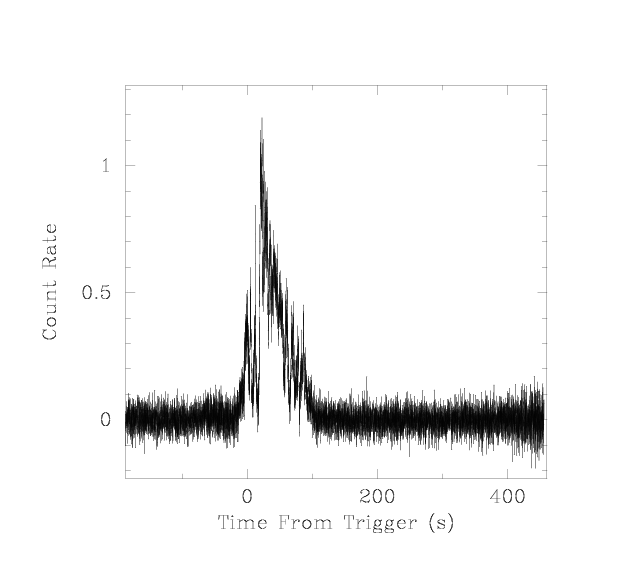
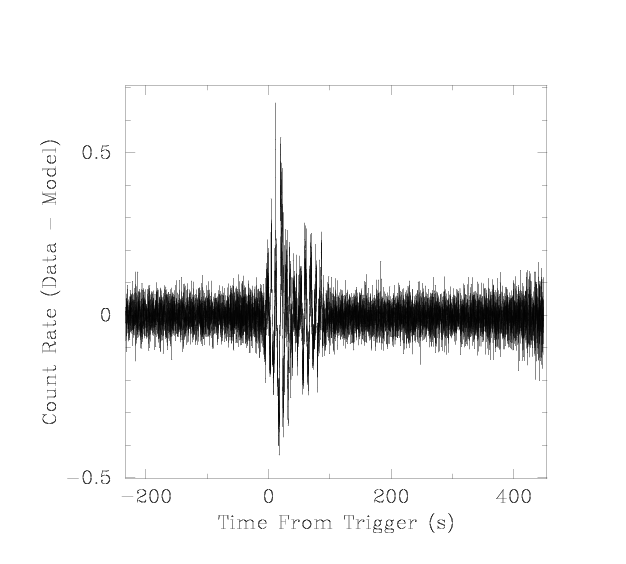
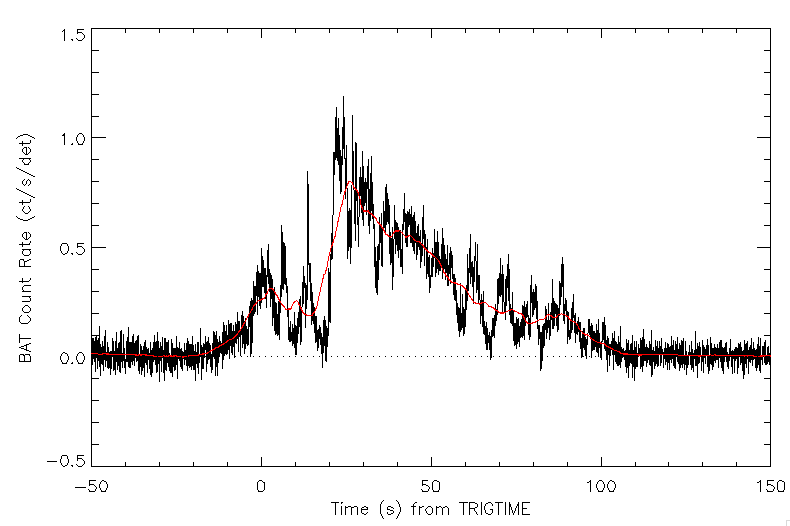
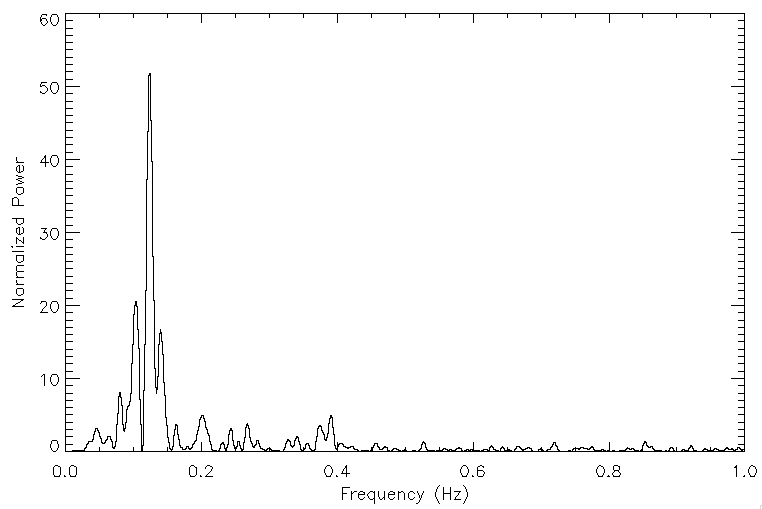
- GCN Circular #9646
S. B. Cenko, J. S. Bloom, A. N. Morgan, and D. A. Perley (UC
Berkeley) report on behalf of a larger collaboration:
We have imaged the field of GRB090709A (Morris et al., GCN 9625) with the
automated Palomar 60-inch telescope. Observations began at 7:40:26 UT on
9 July 2009 (~ 2 minutes after the burst trigger) and were taken in the
r', i', and z' filters.
We marginally detect a faint source at the location of the NIR afterglow
(Aoki et al., GCN 9634, Morgan et al., GCN 9635) in our first r' and z'
images. However, nothing is detected at this location in subsequent
images or deeper coadditions at later times. We therefore cannot
entirely rule out that these represent chance statistical fluctuations.
We report the following photometry and upper limits (referenced with
respected to the USNO-B1 catalog):
UT Midpoint Exposure (s) Filter AB Mag
----------------------------------------------------------------------
7:40:56 60 r' 21.7 +- 0.4
7:45:12 60 r' > 21.4
8:08:57 600 r' > 22.9
7:46:38 60 i' > 21.0
8:11:59 480 i' > 22.8
7:45:55 120 z' 20.5 +- 0.5
8:13:59 480 z' > 21.5
The r' and z' detections, if real, would argue strongly in favor of a low
or moderate redshift origin with a large extinction column in the GRB host
galaxy (Butler, GCN 9639). A combined fit of approximately co-eval
PAIRITEL (GCN 9635, Morgan et al.) and P60 photometry assuming moderate
redshift (z < 4) is consistent with a highly dust-extinguished (A_V > 2
mag) power-law spectral energy distribution.
A smoothed version of our first r' image can be found at:
http://astro.berkeley.edu/~cenko/public/grb/grb090709/p60r.jpg
The blue circle is the refined XRT localization (Osborne et al., GCN
9639), while the red circle is the location of the PAIRITEL NIR afterglow
(Morgan et al., GCN 9635).
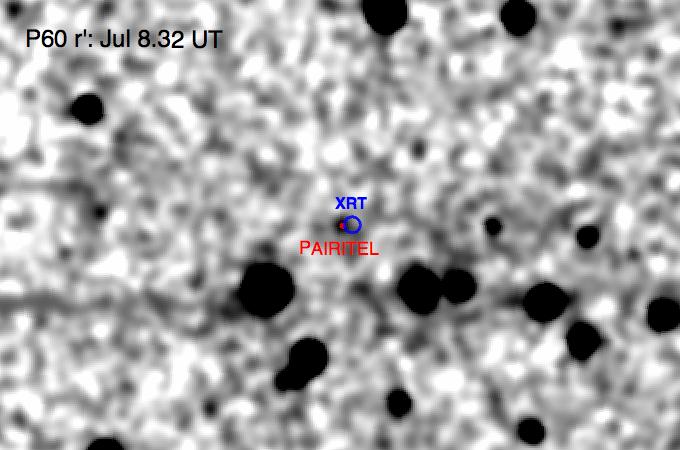
- GCN Circular #9647
S. Golenetskii, R.Aptekar, E. Mazets, V. Pal'shin, D. Frederiks,
P. Oleynik, M. Ulanov, and D. Svinkin on behalf of
the Konus-Wind and Konus-RF teams, and
T. Cline on behalf of the Konus-Wind team, report:
The long GRB 090709A (Morris et al., GCN 9625)
triggered Konus-Wind
at T0=3D27514.965 s UT (07:38:34.965),
and Konus-RF instrument onboard CORONAS-PHOTON s/c
at T0(KRF)=3D27513.934 s UT (07:38:33.934).
The burst light curve shows a multi-peaked structure
with a duration of ~100 s. We confirm presence of
quasi-period in the light curve (Markwardt et al., GCN 9645).
The corresponding peaks in the FFT power spectrum
of 128 ms light curve are clearly seen around
P=3D8.28s (0.1208 Hz) and P=3D16.56s (0.0604 Hz).
The Konus-Wind light curves of this GRB are vailable
at http://www.ioffe.ru/LEA/GRBs/GRB090709_T27514/
The normalized power spectrum of the detrended
Konus-Wind light curve (128 ms, in 20-1150 keV range)
is available at
http://www.ioffe.ru/LEA/GRBs/GRB090709_T27514/GRB090709_T27514_KW_power.p=
ng
As observed by Konus-Wind the burst had
a fluence of (9.1 =B1 0.07)x10-5 erg/cm2,
and a 256-ms peak flux measured from T0+23.308 s
of (3.9 =B1 0.6)x10-6 erg/cm2/s
(both in the 20 keV - 3 MeV energy range).
The time-integrated spectrum of the burst
(from T0 to T0+102.912 s) is well fitted
(in the 20 keV - 3 MeV range) by GRB (Band) model
for which:
the low-energy photon index alpha =3D -0.85 =B1 0.08,
the high-energy photon index beta =3D -2.7(-0.3, +0.2),
the peak energy Ep =3D 298 =B1 27 keV (chi2 =3D 71/67 dof).
The spectrum at the maximum count rate,
measured from T0+16.640 to T0+24.320 s, is well fitted
(in the 20 keV - 3 MeV range) by GRB (Band) model
for which:
the low-energy photon index alpha =3D -0.86 (-0.07, +0.10),
the high-energy photon index beta =3D -2.6(-2.6, +0.53),
the peak energy Ep =3D 416(-100, +95) keV (chi2 =3D 63/67 dof).
All the quoted values are preliminary.
The quoted errors are at the 90% confidence level.
- GCN Circular #9648
C. Guidorzi (U. Ferrara), A. Melandri, C.G. Mundell, D. Bersier,
Z. Cano, S. Kobayashi, I.A. Steele, R.J. Smith (Liverpool JMU),
and A. Gomboc (U. Ljubljana) report, on behalf of a large collaboration:
We re-analysed the data promptly acquired with the 2-m Faulkes
Telescope North in the R and i' filters (Cano et al. GCN 9630)
of the Swift GRB 090709A (Morris et al. GCN 9625).
From the stacked images, we marginally detect a source in the
r' frame at the position of the NIR afterglow found by PAIRITEL
(Morgan et al. GCN 9635), identified as source 'B' by Subaru
(Aoki et al. GCN 9634) and possibly detected in the r' and z' bands
(Cenko et al. GCN 9646). The same object is not detected in the
i' band frame (although with a shorter total exposure).
Start time End time Exposure Filter mag
(min) (min) (s)
-------------------------------------------------------------------
2.88 55.02 720 R 22.7 +/- 0.5
7.55 47.05 520 i' > 20.6
-------------------------------------------------------------------
Calibration was performed against the I and R2 values of the USNOB1
nearby star at 19:19:44.575, +60:43:27.44 assuming I=14.68 and R2=15.70.
We built a tentative SED at the PAIRITEL observation mid time of 438 s
(Morgan et al. GCN 9635), combining the P60 values in the z' filter
(Cenko et al. GCN 9646) and the assuming for the r' filter an
intermediate value comprising both the P60 and our own value.
This value as well as our i' band upper limits were backextrapolated
to the chosen time assuming a range of power-law decay indices, from
0.3 to 1. The SED was finally corrected for the Galactic reddening
of E(B-V)=0.09. We found that the SED can be fitted with a simple
power-law with spectral index beta=3.4 +/- 0.8 (90%cl) and no
evidence for a Lyman drop.
We therefore support the nature of a very red afterglow at low z
(Butler et al. GCN 9639) and possibly associated with a non-GRB
progenitor as suggested by the quasi-periodic oscillations found
in the gamma-ray profile (Markwardt et al. GCN 9645; Golenetskii
et al. GCN 9647).
Our stacked R band frame is available at the following link (red
and green circles show the Swift-XRT and PAIRITEL circles, respectively):
http://www.fe.infn.it/u/guidorzi/GRB090709A/090709A_R.jpg
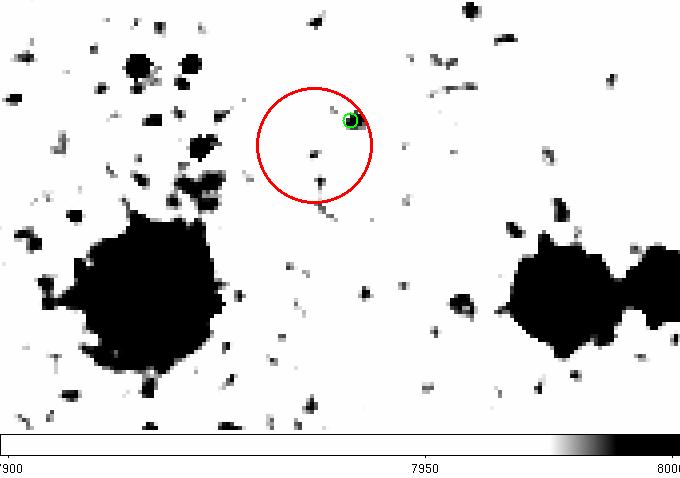
- GCN Circular #9649
D. Gotz (CEA-Saclay), S. Mereghetti (IASF-Milano), A. von Kienlin (MPE
Garching), M. Beck (ISDC Versoix) report:
The Swift GRB 090709A (Morris at al., GCN 9625) is clearly detected
also in the data of Anticoincidence System (ACS) of the spectrometer
SPI on board INTEGRAL. SPI-ACS consists on 91 BGO detectors that are
sensitive to photons above 100 keV, and their light curves are
continuously stored in 50 ms bins. No directional or spectral
information is available. The light curve of GRB 090709A can be found
here
http://ibas.iasf-milano.inaf.it/090709Alc.jpg
The ~8 s periodicity reported by Markwardt et al. (GCN 9645) in the
Siwft/BAT data and by Golenetskii et al. (GCN 9647) in Konus-Wind data
is clearly detected also in the SPI-ACS data. A periodogram over the
entire burst duration can be found here
http://ibas.iasf-milano.inaf.it/090709A.jpg
By fitting the peak of the periodogram using a gaussian function one
obtains a best period of 8.11 s. A light curve folded to the best
period can be fond here
http://ibas.iasf-milano.inaf.it/090709A_folded.jpg
This message can be cited.
- GCN Circular #9651
K. Wiersema, D. Malesani and A. Levan report on behalf of a larger
collaboration:
We observed the field of GRB 090709A (Morris et al., GCN 9625) with the
William Herschel Telescope, using the LIRIS instrument.
We obtained a total of 1890 secs of exposure time in J band, under reasonable
conditions, starting at 04:48 UT July 10th (20.8 hrs after burst).
We do not detect the afterglow (Aoki et al. GCN 9634; Morgan et
al. GCN 9635), with limiting magnitude J>~20. Source A of Aoki et al is
clearly detected.
We are grateful to Don Pollaco and Ian Skillen for performing these
observations.
- GCN Circular #9652
T. A. Pritchard (PSU), E. A. Hoversten (PSU) and D. C. Morris (PSU)
report on behalf of the Swift/UVOT team:
The Swift/UVOT began observing the field of GRB 090709A, 77 seconds
after the BAT trigger (Morris et al., GCN 9625). We do not detect any
source at the Swift enhanced XRT position (Osborne et al., GCN 9636).
The 3-sigma upper limits in each filter are:
Filter T_start(s) T_stop(s) Exp(s) Mag (3-sigma upper limit)
-------------------------------------------------------------
white(FC) 77 227 150 > 21.03
v 4697 4897 200 > 19.59
b 4081 4281 200 > 20.01
u 290 471 181 > 20.09
uvw1 5107 5307 200 > 19.83
uvm2 4902 5102 200 > 19.63
uvw2 4492 4692 200 > 19.85
-------------------------------------------------------------
The quoted upper limits have not been corrected for the expected
Galactic extinction along the line of sight of E_(B-V) = 0.09 mag.
All photometry is on the UVOT photometric system described in Poole et
al. (2008, MNRAS, 383, 627).
- GCN Circular #9653
M. Ohno (ISAS/JAXA), W. Iwakiri (Saitama U.),
M. Suzuki, M. Kokubun, T. Takahashi (ISAS/JAXA),
M. Tashiro, Y. Terada, A. Endo, K. Onda, T. Sugasahara (Saitama U.),
Y. E. Nakagawa, T. Tamagawa (RIKEN), N. Ohmori, A. Daikyuji, E. Sonoda,
K. Kono, H. Hayashi, K. Noda, Y. Nishioka, M. Yamauchi (Univ. of Miyazaki),
K. Yamaoka, S. Sugita (Aoyama Gakuin U.), S. Hong (Nihon U.),
N. Vasquez (Tokyo Tech.), Y. Urata (NCU),
Y. Hanabata, T. Uehara, T. Takahashi, Y. Fukazawa (Hiroshima U.),
on behalf of the Suzaku WAM team, report:
The bright, long GRB 090709A (Swift/BAT trigger #356890 ; Morris et
al., GCN 9625) triggered the Suzaku Wide-band All-sky Monitor (WAM)
which covers an energy range of 50 keV - 5 MeV at 07:38:33 UT (=T0).
The observed light curve shows a multi-peaked structure with a duration
(T90) of about 81 seconds. The corresponding peaks in the FFT power
spectrum of 1 s light curve are clearly seen around P=8.06(-0.20,+0.20) s,
which is consistent with the previous reports (Markwardt et al., GCN 9645;
Golenetskii et al., GCN 9647; Gotz et al., GCN 9649).
The fluence in 100 - 1000 keV was 6.06(-0.36, +0.48) x10^-5 erg/cm^2.
The 1-s peak flux measured from T0+70s was 4.83(-0.69, +0.27) photons/cm^2/s
in the same energy range.
Preliminary result shows that the time-averaged spectrum from
T0-10s to T0+110s is well fitted by a power-law with exponential cutoff model:
dN/dE ~ E^{-alpha} * exp(-(2-alpha)*E/Epeak) with
alpha 0.97(-0.43, +0.52), and
Epeak 439(-58, -48) keV (chi^2/d.o.f. = 62.9/48).
All the quoted errors are at statistical 90% confidence level,
in which the systematic uncertainties are not included.
The light curves for this burst are available at:
http://www.astro.isas.jaxa.jp/suzaku/HXD-WAM/WAM-GRB/grb/trig/grb_table.html
- GCN Circular #9654
"Atish Kamble (U of Amsterdam), A.J. van der Horst (NASA/MSFC/ORAU),
C. Kouveliotou (NASA/MSFC), R.A.M.J. Wijers and E. Rol (U of Amsterdam)
report on behalf of a large collaboration"
The Westerbork Synthesis Radio Telescope observed the position of the GRB090709A
afterglow (Morris et al. GCN 9625) at 4.9 GHz between July 10.71 and 11.26, 2009
(i.e. about 1.67 days after the burst). No radio counterpart to the afterglow was detected
up to three sigma rms limit of 141 microJy. The formal flux measured at the position
of the NIR counterpart (Morgan et al. GCN 9635) is 104 +/- 47 microJy.
We would like to thank the WSRT staff for rapidly scheduling and obtaining
these observations."
- GCN Circular #9655
A. J. Castro-Tirado (IAA-CSIC Granada), A. de Ugarte Postigo (OAB-INAF),
J. Gorosabel, S. Guziy, M. Jel=EDnek (IAA-CSIC), P. Kub=E1nek (IAA-CSIC a=
nd
GACE Valencia), D. P=E9rez-Ram=EDrez (Univ. de Ja=E9n), N. Mirabal (UCM M=
adrid),
A. Llorente, J. M. Castro Cer=F3n (ESAC Villafranca del Castillo), C.
Alvarez (IAC/GTC La Palma) and J. Cepa (IAC Tenerife),
report:
=93Following the detection of GRB 090709A by Swift (Morris et al. GCNC
9625), we have conducted follow-up observations with the 10.4-m Gran
Telescopio Canarias (GTC) at the Observatorio del Roque de los Muchachos
of the Instituto de Astrof=EDsica de Canarias, in the island of La Palma.
Images in the i=92-band filter (7 x 300-s) under 1=94.0 seeing were gathe=
red
with the OSIRIS instrument (Cepa et al. 2009, in prep.) on 11 July 2009,
00:45 UT (i.e. 41 hr after the event).
At the position of the reported nIR/optical afterglow (Aoki et al. GCNC
9634, Morgan et al. GCNC 9635, Cenko et al. GCNC 9646) we detect no singl=
e
object down to i=92 ~ 25.5 (preliminary 3-sigma limit), or i=92 ~ 25.2 wh=
en
taking into account the foreground Galactic extinction. We note two nearb=
y
faint objects, which lie 3=94.3 south-east and 4=94 north of the afterglo=
w.
The stacked GTC .jpg image is available at the following link:
http://www.iaa.es/~gss/GRB090709A
Although we cannot exclude that GRB 090709A occurred in a low redshift
galaxy (Butler et al. GCNC 9639, Guidorzi et al. GCNC 9648), our
non-detection of a host galaxy, together with the reported 8-s
quasi-periodic oscillations (Markwardt et al. GCN 9645, Golenetskii et al.
9647, Gotz et al. GCNC 9649, Ohno et al. GCNC 9653) and the fact that the
event is at galactic coordinates of about (l =3D 91, b =3D 20) cannot rul=
e out
that the initial observed gamma-ray emission arose from a nearby magnetar
candidate in the Milky Way, much closer than GRB 070610 / SWIFT
J195509+261406 (Castro-Tirado et al. 2008, Nature 455, 506).
Multiwavelength observations are encouraged.
We acknowledge the excellent support from the GRANTECAN staff.
This Circular can be quoted.
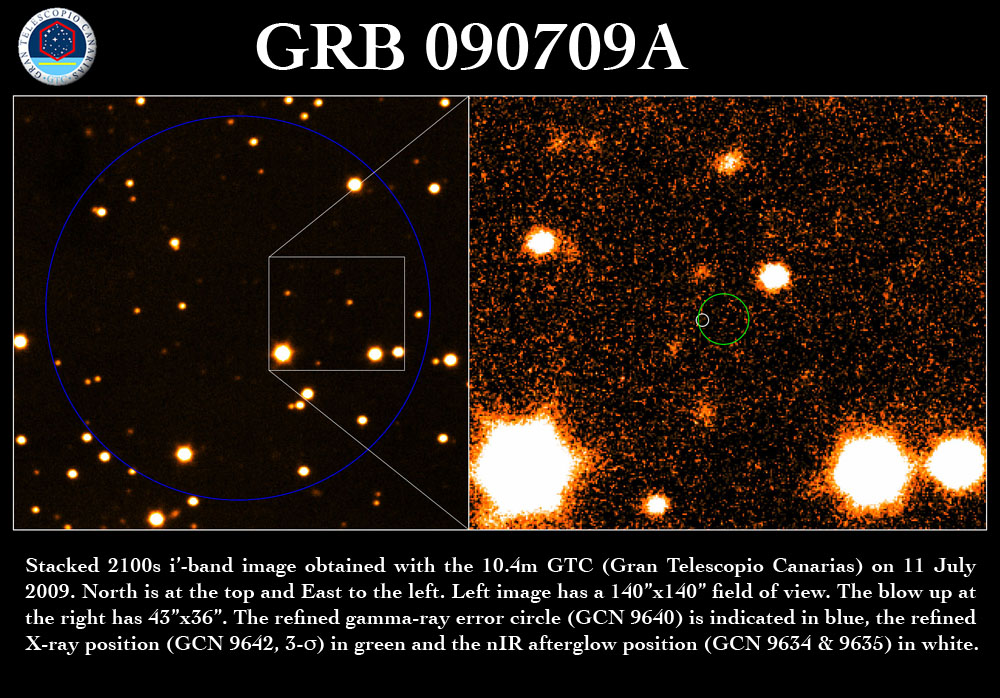
- GCN Circular #9657
Poonam Chandra (RMC) and Dale A. Frail (NRAO) report on behalf of a
larger collaboration:
"We used the Very Large Array to observe the field of view towards the
GRB 090709A (GCN 9625) at a frequency of 8.46 GHz on 2009 Jul. 10.46
UT and Jul. 11.42 UT, and at a frequency of 1.43 GHz on 2009 Jul. 11.39
UT. The GRB radio afterglow is undetected at the PAIRITEL NIR afterglow
position (GCN 9635). The peak flux at the GRB afterglow position on 11th
July observations is 62+/-35 uJy in 8.46 GHz band and 79+/-144 uJy at
1.43 GHz band.
The National Radio Astronomy Observatory is a facility of the National
Science Foundation operated under cooperative agreement by Associated
Universities, Inc."
- GCN Circular #9658
L.P. Xin, W.K. Zheng, Y.L. Qiu, J.Y. Wei, J. Wang,
J.S. Deng and J.Y. Hu on behalf of EAFON report:
We have observed GRB 090709A (Morris et al.GCN 9625)
with Xinglong TNT telescope from July 9, 13:41:18 (UT),
6.04 hour after the burst. After combined 10*600s R
band images, no new source or afterglow counterpart (Morgan et al.GCN
9635;Guidorzi et al. GCN 9648) was
found in our combined image within the XRT errorbox (Morris et al. GCN
9625).
The uplimit is estimated to be about 20.6 mag at the mean time
of 6.816 hours since the trigger.
This message may be cited.
For more information about Xinglong GRBs Follow-up
observations, please visit the website:
http://www.xinglong-naoc.org/grb/
- GCN Circular #9685
A. N. Morgan, G. C. Bower (UC Berkeley), report:
We observed the field of GRB 090709A (Morris et al., GCN 9625) with
the Combined Array for Research in Millimeter-Wave Astronomy (CARMA)
at an average frequency of 88.5 GHz beginning at 2009-07-15 04:41:33
UT, ~5.88 days after the Swift trigger. No source was detected at the
position of the NIR/optical afterglow (Aoki et al., GCN 9634; Morgan
et al., GCN 9635; Cenko et al., GCN 9646; Guidorzi et al., GCN 9648)
down to the following limits:
post_burst
t_mid(d) exp(h) freq_mid(GHz) bandwidth(MHz) flux (mJy)
5.98 3.79 88.5 3000 < 1.1 (3 sig)
The quasar 1849+670 was used as a phase calibrator, and fluxes were
calibrated to an observation of Neptune taken at the end of the track.
We thank the staff and observers at CARMA and instructors of the CARMA
Summer School for excellent support during the observations and
analysis.
- GCN Circular #9696
N. Mirabal (U. Complutense de Madrid) and E. V. Gotthelf (Columbia U.)
report:
In light of recent reports of quasi-periodic variations in the
gamma-ray light curve of GRB 090709A (Markwardt et al., GCN 9645;
Golenetskii et al., GCN 9647, Gotz et al., GCN 9649; Ohno et al.,
GCN 9653), we have analyzed Swift XRT observations of GRB 090709A
obtained between 2009 July 9.319 UT and 2009 July 11.862 UT
(79s - 61 hr after the trigger assuming T at 2009 July 9, 07:38:34 UT).
This period overlaps the BAT light curve from T+79 s to T+150 s
(Markward et al., GCN 9645). The first set of observations (390 s) was
taken in WT mode (1.77 ms timing resolution), followed by three
pointings in PC mode (2.5 s timing resolution). Fast Fourier
Transform (FFT) analysis applied to the light curves
in each interval shows no significant power down to the Nyquist
limit of f < 283 Hz and f < 2 Hz, for the WT and PC mode data,
respectively. Furthermore, the power spectrum of the first 120 s
of WT mode data (79-469 s after the trigger) does not reveal
any significant signal. The FFTs show typical characteristics of both
white and red noise during the interval. The absence of oscillations in
the X-ray band appears to rule out coherent quasi-periodic variations
extending beyond T+150 s. We note that the 8-second cycle derived from
the gamma-ray light curve seems at odds with the spin period P ~ 1 ms
required to produce an energy release Egamma ~ 10^50 erg from a magnetar
engine (Thompson et al. 2004, ApJ, 611, 380), unless the neutron star
was born
a millisecond pulsar and spun down to a 1-8 s period (depending on the
actual GRB redshift) on a ~10 s timescale.
The power spectrum of the GRB 090709A light curve (WT mode, 79-469 s
after the trigger) can be found at:
http://www.gae.ucm.es/~mirabal/grbs/grb090709a/grb090709a_fft.gif
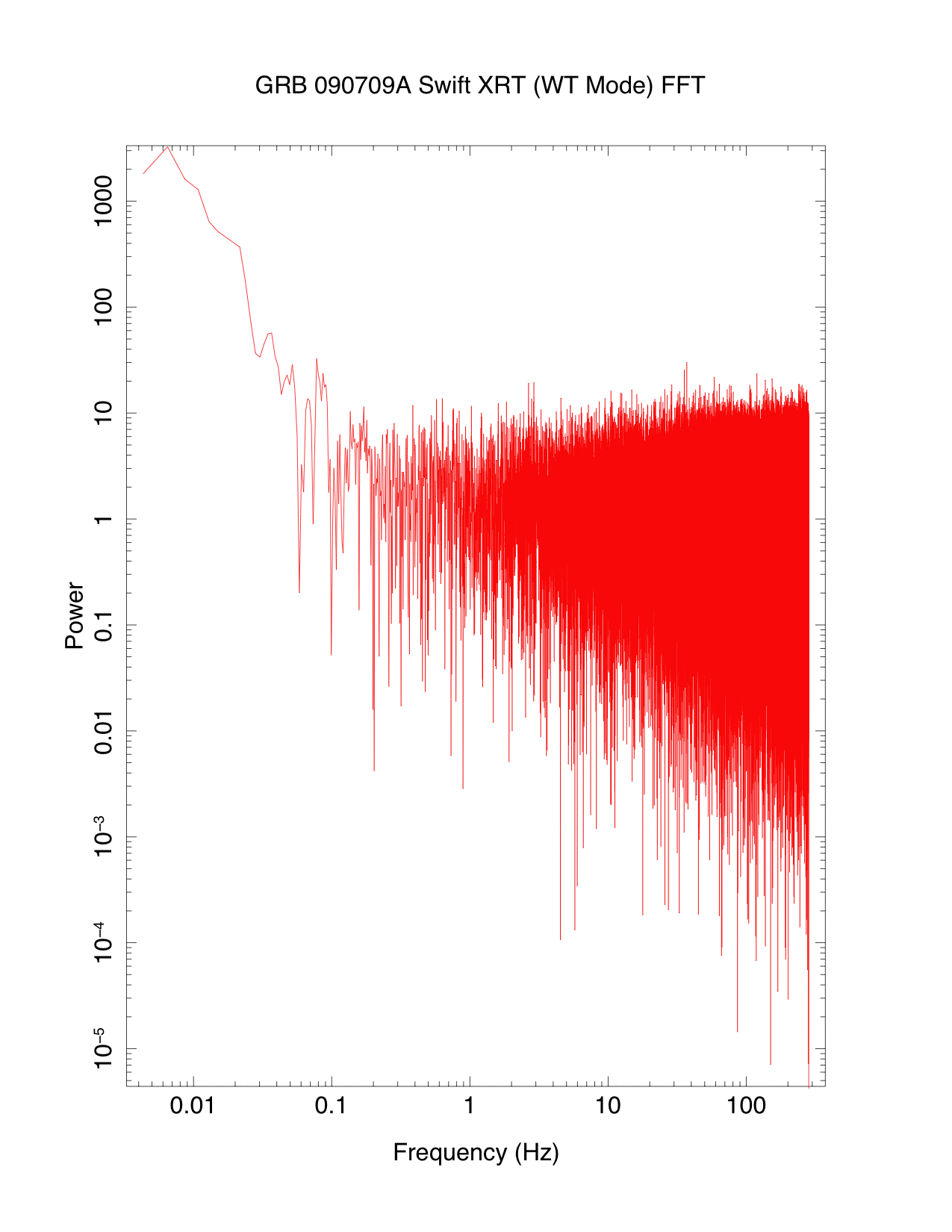
- GCN Circular #9737
Y. E. Nakagawa, T. Tamagawa (RIKEN), K. Yamaoka, S. Sugita, A. Yoshida
(Aoyama Gakuin University), R. Sato, M. Ohno (ISAS/JAXA), K. Nakazawa
(University of Tokyo), M. Tashiro, T. Sugasahara, W. Iwakiri, K. Onda
(Saitama University), Y. Urata (National Central University), D. Yonetoku,
T. Murakami (Kanazawa University), N. Kawai, R. Usui, H. Nakajima, A. Endo
(Tokyo Institute of Technology), M. Yamauchi, E. Sonoda, N. Ohmori,
K. Kohno, H. Hayashi, A. Daikyuji, K. Noda, Y. Nishioka (University of Miyazaki),
M. Suzuki (TKSC/JAXA), F. Tazaki, S. Eguchi, K. Kubota, Y. Ishino, K. Hiroi,
Y. Ueda (Kyoto University), on behalf of the Suzaku GRB ToO team, report:
We report on a Suzaku ToO observation of the GRB 090709A X-ray afterglow
(Morris et al. 2009, GCN 9625), started on 2009-07-09 13:16:17 UT,
for a net exposure time of about 62 ksec (Mitsuda et al. 2009, GCN 9632).
The observation covers time ranging from 23 ksec to 135 ksec after the
Swift/BAT trigger time (2009-07-09 07:38:34 UT). The X-ray afterglow was
clearly detected in the XIS CCDs at a position consistent with that of
the Swift/XRT observations (Morris et al. 2009, 9625). The 0.2-12 keV
light curve is well fit by a power law with a decay index of 1.53+/-0.02.
A preliminary analysis of the XIS data shows that a time average spectrum
in 0.2-12 keV band is well fit by a power law with a photon index of
2.02+/-0.03, absorbed by a hydrogen column density of (2.2+/-0.2)*10^21 cm^-2.
The unabsorbed 0.2-12 keV flux is (5.2+/-0.2)*10^-12 ergs cm^-2 s^-1.
The XIS data confirm the hydrogen column density in excess of the
Galactic value of 6.6*10^20 cm^-2, consistent with the Swift/XRT result
(Rowlinson et al. 2009, GCN 9642).
We would like to thank the Suzaku managers and the operation team
for approving and carrying out the ToO observation.
- GCN Report 235.1
GCN_Report 235.1 has been posted:
http://gcn.gsfc.nasa.gov/reports/report_235_1.pdf
by D.C. Morris
at GWU/GSFC
titled: "Final Results on Swift GRB 090709A"
- GCN Circular #10903
D. A. Perley, S. B. Cenko, and J. S. Bloom (UC Berkeley) report:
We observed the field of GRB 090709A (Morris et al., GCN 9625) using
NIRI on Gemini-North on the night of 2010-06-23 between 11:54 and 14:46
UT, under good conditions. Our co-added stack contains a total of 146
images of 60 seconds each (2.43 hours of imaging) in the K' filter. The
3-sigma limiting magnitude of the stack is K' ~ 23.7. (Calibration of
the field was established relative to several 2MASS stars in the image.)
Matching our image directly to early-time PAIRITEL imaging (Morgan et
al., GCN 9635), we detect a faint, extended source slightly offset (0.6
arcsec) from the position of the IR afterglow. The orientation of the
offset is along the apparent direction of extension of the source (E-W).
Aperture photometry within a 1.0 arcsec aperture centered on the
object gives a magnitude of K' = 22.0 +/- 0.2 mag. The chance
probability for this alignment is approximately one percent (Bloom et
al. 2002, AJ 123:1111, Djorgovski et al. 1995, ApJL 438:L13).
We therefore associate this object with the host galaxy of GRB 090709A.
The detection of a host galaxy confirms the extragalactic,
cosmological nature of this event (de Luca et al. 2010, MNRAS 402:1870;
Cenko et al. 2010, AJ 140:224). We note that deep optical imaging of
this field by the GTC (Castro-Tirado et al., GCN 9655) detected no
object at this position to a limit of i' > 25.5, suggesting that the
host galaxy may be internally dust-reddened. The infrared afterglow
also showed evidence of strong reddening (Cenko et al. 2010), and
foreground extinction in this direction is low; E(B-V) = 0.09 mag.
Additional imaging is encouraged to test this hypothesis.
An image of the field is posted to:
http://lyra.berkeley.edu/~dperley/090709a/090709a_niri.png
We are happy to thank Marie Lemoine-Busserolle, Matthew Dillman, and
Andrew Stephens for their support during our classical NIRI run.
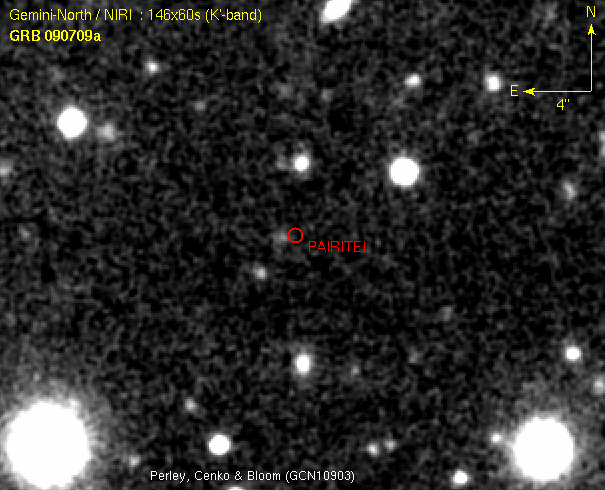
- 1101.3909 from 21 Jan 11
Houri Ziaeepour et al.: Broad band simulation of Gamma Ray Bursts (GRB) prompt emission in presence of an external magnetic field
The origin of prompt emission in GRBs is not yet well understood. The simplest and most popular model is Synchrotron, Self-Compton (SSC)
emission produced by internal shocks inside an ultra-relativistic jet. However, recent observations of a delayed high energy component by the
Fermi-LAT instrument have encouraged alternative models. Here we use a recently developed formulation of relativistic shocks for GRBs to
simulate light curves and spectra of synchrotron and self-Compton emission. We also extend the previous formulation by considering the presence
of a precessing external magnetic field. Our simulations reproduce light curves of real GRBs and variety of spectral slopes at E > E_peak
observed by the Fermi-LAT. The high energy emission can be explained by synchrotron emission and a subdominant contribution from inverse
Compton. We also suggest an explanation for extended tail emission and relate it to the screening of the magnetic field and/or trapping of
accelerated electrons in the electromagnetic energy structure of the plasma in the shock front. Spectral slopes of simulated bursts at E <
E_peak are consistent with theoretical prediction and steeper than observations. We show that this discrepancy is due to the unrealistic abrupt
break considered in the distribution of electrons and there is a significant contribution at E < E_peak from low Lorentz factor electrons. As
for the effect of an external magnetic field, we show that due fast variation of other quantities, its signature in the Power Distribution
Spectrum (PDS) is significantly suppressed and only when the duration of the burst is few times longer than the oscillation period it can be
detected, otherwise either it is confused with the Poisson noise or with intrinsic variations of the emission. Therefore, low significant
oscillations observed in the PDS of GRB 090709a are most probably due to a precessing field.(Abbrev.)
![]() Previous IAU Circulars
Previous IAU Circulars 
















